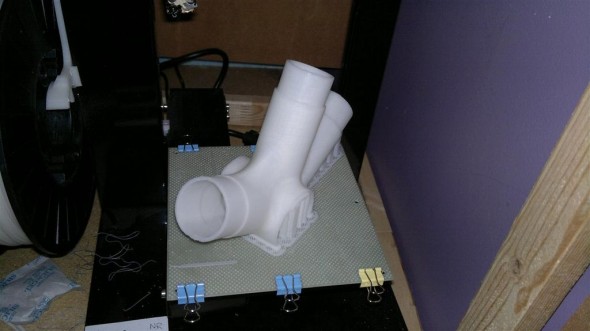If you’ve been following the news out of SXSW this year you know the big story is the rise of 3D printers and scanners, bringing small-scale manufacturing to the desktop for the first time. Which got us thinking: what will this mean for mountain bikes of the future? Here are some ideas.
Get any part you need at any time
Home mechanics know this situation all too well: You just installed a new fork and you’re all ready to button everything up but realize you need a couple more spacers. Or you replace your derailleur cables and can’t find the stupid ferrules. If you had a 3D printer at home, you could just download a design file and get the exact parts you need and you could even customize them. Instead of using a stack with 3, 5, and 10mm spacers, you could print out a single spacer that’s exactly the size you need.
Even if 3D printers don’t filter down to every home mechanic, they’ll still be a boon to the local bike shop. Instead of having to stock hundreds of tiny parts or wait for special orders to come in, shops will simply have a 3D printer and access to design files directly from all the bike manufacturers. Need a derailleur hanger for your Yeti SB95? No problem, the shop will just print one out and you’ll be back in business!
With 3D printers, restoring vintage mountain bikes will be even easier. Nobody makes the part you need anymore? Find someone who has the part you need, scan it, and print out a copy. Or, design a replacement part yourself before printing.
Innovative design
One of the coolest things about 3D printing and the associated software is that it does a lot of the design and strength calculations for you in an effort to minimize material waste. For example, a tube (think handlebar or bike frame member) can be printed with internal struts at strategic locations to provide the necessary rigidity without making the part unnecessarily thick or heavy. This opens up all sorts of design and material possibilities frame and parts designers have never dreamed of. It also opens the world of bike frame and parts design to more of us regular Joes.
Admittedly, the first 3D-printed bikes don’t really resemble today’s mountain bikes but it’s only a matter of time. This 3D-printed bike featured on Engadget is nothing if not ambitious–nearly every part has been 3D-printed including the wheels and the (sort of) bottom bracket. Note the structural lattice pattern on the saddle and the frame.
While we may be a long way off from fully 3D-printed mountain bikes, folks are already experimenting with printing socket-style frame lugs. This Instructables tutorial explains the process of using 3D-printed lugs to join metal, carbon fiber, or even bamboo tube stock into a fully functional bike.
Today 3D printing is already being used by bike companies like Trek as a rapid prototyping tool. In the old days it might take weeks or months to get a design sample back from the factory, only to find major flaws in a design. Now, designers can send design files directly to a 3D printer to get a feel for how they will behave in real life.
Custom parts for your mountain bike
Sure, you can order a custom-built mountain bike with the exact frame geometry to fit your body but most of us will continue to buy small, medium, and large bikes off the shelf. Yes, it’s possible to swap out stems and seat posts but even those come in just a few select sizes. Imagine printing out a stem that’s exactly the size you need–say 97mm–created from a tweaked Easton design file the company provided to your shop.
And don’t think all 3D-printed objects come out white like the images shown above. There are already color 3D printers on the market and the sky is the limit in terms of color and design choices for 3D-printed parts. One day it will be possible to truly customize your ride exactly the way you want it.
Challenges
Of course all this technology also poses a risk to the bike industry. 3D scanners will make it possible for anyone to scan a part and print a near perfect replica in the privacy of their own home. Or worse, folks will start scanning parts and uploading the files to the internet for anyone to print at home.
And with the ability to make their own parts, consumers may visit the local bike shop even less than they do now (though in the near term a 3D printer in the LBS could be a nice boost). Even the internet and mail order companies could suffer as manufacturers simply deliver electronic design file directly to consumers to fabricate themselves.
Today’s 3D printers, especially those targeting the consumer market, can only print plastic or resin which limits much of what they can address in the bike market (for example, you wouldn’t want to make a chain or cassette out of plastic). However, even if 3D printers capable of printing metal or carbon fiber materials don’t filter down to the home, they will be available to individuals through shared maker spaces and manufacturing facilities.
Your turn: How will 3D printing affect the future of mountain bikes?





















